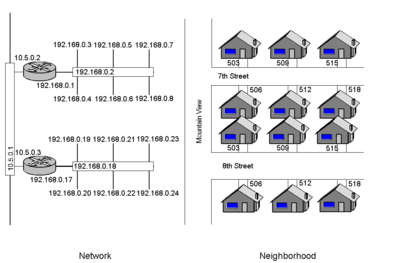This is an old revision of this page, as edited by Gjp23 (talk | contribs) at 09:15, 19 June 2007 (Reverted 5 edits by 203.112.80.138 identified as vandalism to last revision by Jjron. using TW). The present address (URL) is a permanent link to this revision, which may differ significantly from the current revision.
Revision as of 09:15, 19 June 2007 by Gjp23 (talk | contribs) (Reverted 5 edits by 203.112.80.138 identified as vandalism to last revision by Jjron. using TW)(diff) ← Previous revision | Latest revision (diff) | Newer revision → (diff)
A router is a computer networking device that buffers and forwards data packets across an internetwork toward their destinations, through a process known as routing. Routing occurs at layer 3 (the Network layer e.g. IP) of the OSI seven-layer protocol stack.
Function

A router acts as a junction between two or more networks to buffer and transfer data packets among them. A router is different from a switch and a hub: a router is working on layer 3 of OSI model, a switch on layer 2 and a hub on layer 1. This makes them work for different situations: a switch connects devices to form a Local area network (LAN) (which might, in turn, be connected to another network via a router).
One easy illustration for the different functions of routers and switches is to think of switches as neighborhood streets, and the router as the intersections with the street signs. Each house on the street has an address within a range on the block. In the same way, a switch connects various devices each with their own IP address(es) on a LAN. However, the switch knows nothing about IP addresses except its own management address. Routers connect networks together the way that on-ramps or major intersections connect streets to both highways and freeways, etc. The street signs at the intersection (routing table) show which way the packets need to flow.
So for example, a router at home connects the Internet Service Provider's (ISP) network (usually on an Internet address) together with the LAN in the home (typically using a range of private IP addresses, see network address translation) and a single broadcast domain. The switch connects devices together to form the LAN. Sometimes the switch and the router are combined together in one single package sold as a multiple port router.
In order to route packets, a router communicates with other routers using routing protocols and using this information creates and maintains a routing table. The routing table stores the best routes to certain network destinations, the "routing metrics" associated with those routes, and the path to the next hop router. See the routing article for a more detailed discussion of how this works.
Routing is most commonly associated with the Internet Protocol, although other less-popular routed protocols are in use.
History
The first Internet router was developed at BBN as part of their contract to build out the original Arpanet. The first multiprotocol router was created at Stanford University by a staff researcher named William Yeager in January of 1980. His boss at the time told him that he was the "network guy" and to find a way to connect the computers in the computer science department, medical center and department of electrical engineering. He first wrote a network operating system and routing code to run on a DEC PDP11/05. He used Alan Snyder's Portable C compiler but it generated too much code so he modified the compiler to improve the code generators.That still wasn't good enough so he wrote an optimizer for PDP11/05 assembler that reduced the code size further.
Types of routers
In the original era of routing (from the mid-1970s through the 1980s), general-purpose mini-computers served as routers. Although general-purpose computers can perform routing, modern high-speed routers are highly specialized computers, generally with extra hardware added to accelerate both common routing functions such as packet forwarding and specialised functions such as IPsec encryption.
Other changes also improve reliability, such as using DC power rather than line power (which can be provided from batteries in data centers), and using solid-state rather than magnetic storage for program loading. Large modern routers have thus come to resemble telephone switches, with whose technology they are currently converging and may eventually replace, whilst small routers have become a common household item.
A router that connects clients to the Internet is called an edge router. A router that serves solely to transmit data between other routers, e.g. inside the network of an Internet service provider, is called a core router.
A router is normally used to connect at least two networks, but a special variety of router is the one-armed router, used to route packets in a virtual LAN environment. In the case of a one-armed router, the multiple attachments to different networks are all over the same physical link.
In mobile ad-hoc networks every host performs routing and forwarding by itself, while in wired networks there is usually just one router for a whole broadcast domain.
See also
- Access point
- Flapping router
- History of the Internet
- Network address translation (NAT)
- Network bridge
- Network switch
- TR-069
- Wi-Fi
External links
- Interview with William (Bill) Yeager, Inventor of the router
- HowStuffWorks: How Routers Work by Curt Franklin
- www.bsdrouter.org - website that covers router software based on BSD operating systems
- Linux Advanced Routing & Traffic Control HOWTO
- Animation of routing process